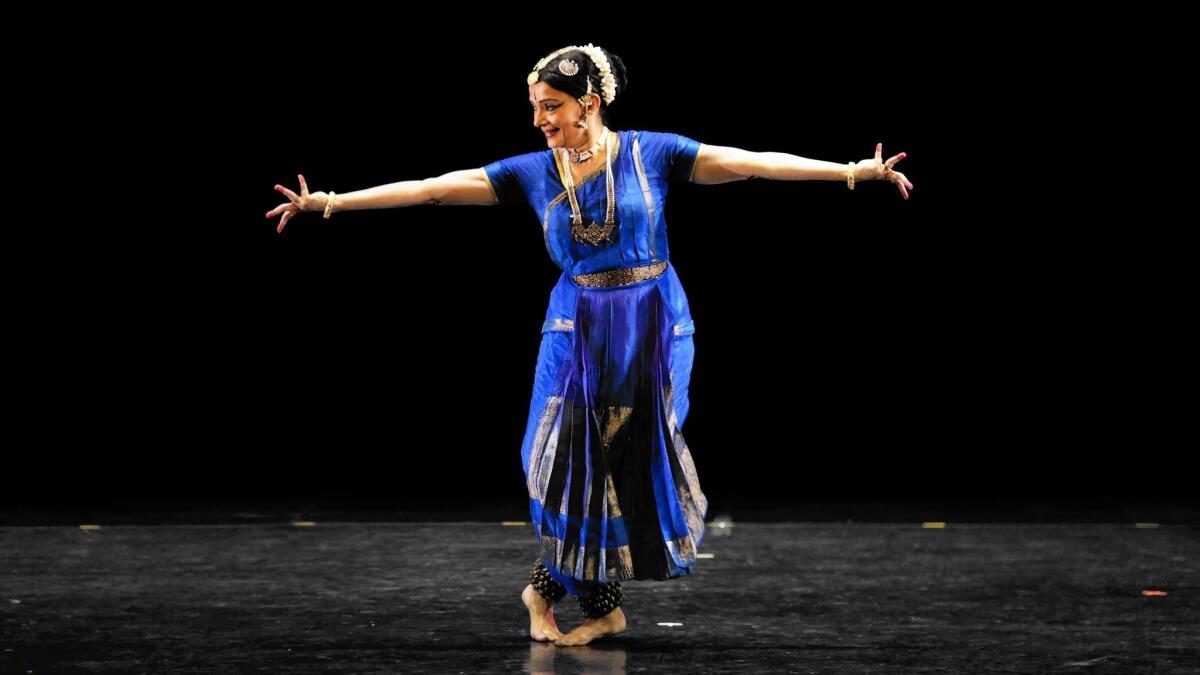Review: In dance, Malavika Sarukkai explores and expresses the essence of the Ganges

- Share via
The struggle to preserve the soul of India, from within the country and without, has been going on for so long that the struggle itself now seems to be part of India’s soul.
The country’s national poet, Rabindranath Tagore, was accorded a Nobel Prize in 1913 and favored by the likes of Yeats, only to have Yeats and other notable British poets turn on him for, they thought, losing his exoticism.
Certain raga connoisseurs attacked Ravi Shankar for his sitar showmanship and the sacrilege of exposing a spiritual art to the expedients of rock festivals. India’s greatest filmmaker, Satyajit Ray, was accused of exploiting the country’s poverty and not representing modern India.
On Sunday afternoon, Malavika Sarukkai, internationally the best-known exponent of South Indian classical dance, gave a solo performance at the Broad Stage. Dressed in traditional Indian costume, she explored and expressed the essence of the Ganges. Through stately movement, through complex gestures with her hands, through elaborate dance steps, through imposing facial expressions, she became the river and its spirit, its divinities and its inhabitants.
She was the god Shiva, from whose twisted locks the river originally flowed. She was a courtesan in Benares, also known as the holy city of Varanasi. She was the lone voice of the river, choking from pollution, spiritual and physical. She was the Ganges as giver of life and, as the river loses its identity when it merges into the sea, taker of the ego.
Sarukkai has a mesmerizing presence on stage, with the startling ability to change instantly, as the river might, from beguiling to intimidating. A master of the postures Bharata Natyam, she can be one moment a luminous beauty, the next a grotesque threat.
The dance form has ancient roots. You can find some of the dance positions on reliefs in temples in India thousands of years old. Sarukkai is a representative of tradition, but she is also not entirely true to it. She brings new and contemporary ideas, to say nothing of her own daunting personality.
This may make her readily appreciated by those of us not schooled in the intricacies of Bharata Natyam. But there are experts and enthusiasts who disapprove of her style, her secular and personal approach, her involvement with the social elite rather than returning dance to the people. Politics in the Indian dance world is inescapable as it is in every aspect of Indian life.
If Sarukkai is not entirely true to the spiritual purity of Bharata Natyam, she can produce it, as she did in her final dance celebrating nonduality as the river become the ocean. But her main attraction may be simply that she is a consummate performer.
Few dancers can hold the stage alone, with nothing but their wits, for 80 minutes the way Sarukkai can. So whether or not Sarukkai preserves the soul of Bharata Natyam, she conveys the soul of the Ganges with enough brilliance that I trust her to tell me at least something about the essence of her dance.
That dance is, in great part, a highly developed and ritualized art of storytelling, often through the means of seduction. Sensuality has, however, also become ritualized over the centuries, and part of the purist tradition is to bring it back. Environment matters. Dancer and musicians need to become one, just like the river and sea. A temple setting puts a viewer in a different spiritual state than does a darkened Broad Stage broken by audience members who were turning on cellphones.
For “Ganga Nitya Vaahini” (The Eternal River), the choreography, while based on tradition, was mainly Sarukkai’s own. The five sections relied on texts from different historical sources and different music. The music was recorded, which did the most to remove Sarukkai’s recital from being part of a living tradition, but the event was quickly organized by the Shakti Dance Company and its Los Angeles school, where Sarukkai had spent the previous week as a guest instructor.
Remarkable lighting by Eileen Cooley took Sarukkai almost into the abstract realm of Robert Wilson. Each part went from dark to light to dark in a different way, a different dawn to day to night on the Ganges. Maybe Sarukkai’s most astonishing innovation is in exploiting the changing light to seemingly transform herself into different beings.
Ultimately, Sarukkai’s brilliance is more of evocation than explication. She was not so different as courtesan or goddess, and I was never sure what was meant as a gesture of devotion or seduction.
But Marvel Comics could create whole characters out of the different kinds of magical powers Sarukkai revealed. Her fingers appear to produce sparks of electricity that illuminate watery currents. Her arms act like human windmills generating energy. Her feet move with music to move the earth. She stops time with poses. Her gaze is hypnotic.
Sarukkai’s eternal river is today’s Ganges. It is a river with a history flowing through a radically modernizing country seeking new energy sources, ever uncertain of how to hold on to its soul but fortunately still aware that it has one.
More to Read
The biggest entertainment stories
Get our big stories about Hollywood, film, television, music, arts, culture and more right in your inbox as soon as they publish.
You may occasionally receive promotional content from the Los Angeles Times.











